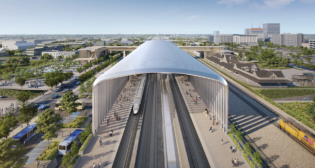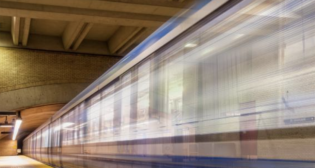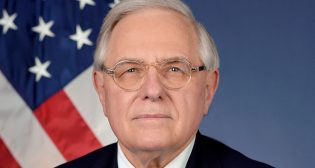
How private enterprise can strengthen Amtrak
Written by William C. Vantuono, Editor-in-ChiefHouse Transportation & Infrastructure Committee Chairman John Mica (R-Fla.) has made no secret of his disdain for Amtrak, often referring to it as our “Soviet style rail system.”
Accepting the premise that Mica’s desires for a better and more extensive intercity passenger rail system are genuine, his committee has a golden opportunity to open the doors to private sector investment and involvement in the modernization and growth of our nation’s intercity passenger rail system.
However, Mica has only touched on where, and how, the private sector can begin to play a much larger role in delivery of, and investment in, our national passenger rail system. If our political leaders from both parties can come to a consensus and provide a dedicated and predictable annual federal capital funding stream for intercity passenger rail, the private sector will respond. The private sector need not replace Amtrak, but rather partner with it, to strengthen what Amtrak does best (operating trains), and incorporate what the private sector does best (manage and grow customer focused businesses, and generate profits from them). Such an unlikely business partnership can help transform our country’s intercity passenger rail network into something more akin to what the rest of the world’s industrialized nations are already providing to their people: modern higher performance and higher speed trains, but with a decidedly “American” twist.
We must remember that the private sector (private railroads) gave up on intercity passenger rail service in the 1960s and 70s. More important, we must remember why the railroads gave up. As private businesses, all the costs of passenger service were borne by the private railroads. Capital investment had to be raised in the marketplace, operating costs had to be covered from revenues, and such costs and investments had to make economic sense (result in a profit). The cost of passenger service did not meet those criteria. The private railroads are not in the business of running trains. They are in the business of making money. Running trains is simply how they do it. This is the hallmark of our capitalist system. For any passenger operation to “make a profit,” the business model must be robust, diverse, and capitalized, with extensive revenue being generated from multiple non-passenger fare sources.
When the federal government decided to provide the capital funding for new highway construction with public tax dollars, the railroads found that they could not raise enough capital on the private marketplace to compete for the passenger rail market, along with bearing the liability that comes with transporting passengers. When the federal government began subsidizing the capital cost of airports, with many military airfields simply “transformed” and shed at nominal cost into publicly owned commercial airport facilities, the private railroads began to start a serious effort to divest themselves of passenger services. They could no longer run a competitive business bearing 100% of the required capital and operating costs, while roadway users and airline competitors paid only a small “user fee” to have access to these massively expensive, publicly built and funded facilities. Railroads simply could not raise the kind of capital needed and make economic sense of intercity passenger rail service.
Today’s freight railroads might be expected to participate constructively in cooperative development of a rejuvenated, higher performance passenger rail system, but their business model no longer allows them to be sources of capital investment or operating support for passenger services. To accomplish this would require the freight railroads to pour billions of dollars into their infrastructure for double-tracking, sidings, signaling, etc., and that’s not going to happen.
However, cooperative “business deals” are possible, as are evidenced by the successful public-private partnerships between the Union Pacific and the Capitol Corridor Joint Powers Authority in Northern California; the Northern New England Passenger Rail Authority’s Downeaster service and Pan Am Railway in Maine; and North Carolina DOT’s Piedmont/Carolinian service and the North Carolina Railroad and Norfolk Southern.
In each of these partnerships, the public sector partner provided the required capital funding. Amtrak is also the operating partner, and brings significant strength regarding the provision of liability coverage. So as we move toward greater “private sector involvement” in the delivery of a rejuvenated and expanded intercity passenger rail system, we need to look where that involvement makes the most sense to foster both a competitive business environment, as well as to provide people with the travel choice of a modern, cost-effective intercity passenger rail system. The private sector excels at delivery of customer-focused services. Businesses flourish with happy customers. Happy customers spend money on the service. The money collected from customers grows to further expand the business. This is not “revelation,” but basic business. It is the foundation upon which America’s economy is built. Often, it is the ancillary services, and such popular real estate concepts as Transit Oriented Development (TOD, or Smart Growth) that bring the real revenue generation, but the catalyst for the private investment is the existence of the passenger rail service itself.
How do we get private businesses into the intercity passenger rail business? By setting the stage for them to do what they do best: run a profitable business. We fostered the growth of an entirely new private trucking industry for shipment of goods around the country when the public capital funds were provided to build our highway system. We set the stage for the growth of the private airline industry when we provided the public capital funding to build, improve, and expand airports (with more than a little help from the technology advances in military aircraft, designed and funded with tax dollars), and publicly funded the air traffic control system to facilitate the movement of aircraft in our country.
If the public provides the up-front capital for the bulk of major investments needed to establish intercity passenger rail services, why would we not expect the private sector to respond by seeking ways to implement development along existing lines and helping to foster new services? In many cases today, Amtrak could be a partner with the private sector, but it must welcome that partnership and not try to do so much internally.
When businesses grow (and Amtrak is growing), they sometimes lose sight of “their primary mission. Example: When an architectural/engineering firm grows to the point where it can occupy all or most of the space in its own building, it often find itself buying a building and then ending up being in the property management/maintenance business, which is not its core business. What happens? As attention to the property management function escalates, expertise and talent are diverted from the core business. Amtrak suffers from some of this “diversionary activity” in its effort to control everything associated with managing and operating an intercity national passenger railroad. Again, remember, the private railroads were (and still are) diverse companies, with many interests and revenue generators.
It is clearly recognized that no private company (or companies) could have raised the up-front capital necessary to build the interstate highway system, or build the nation’s airports, or support the air traffic control system. So why would anyone think that the private sector could raise the up-front capital cost of building an intercity passenger rail system? The debt service alone would make private financing of any large public infrastructure project unfeasible, be it a highway, an airport, or an intercity passenger rail system. However, if there is a predictable stream of public up-front capital investment funding, and Amtrak and the states reach out to build a business partnership with private interests, then a vibrant, expanded and modern intercity passenger rail system can be the result.
Our country will get the transportation systems it is willing to fund. We have the interstate highways because we set up a federal capital funding stream. We have done the same for airports, mass transit, and canals and ports. Until two years ago, nearly 40 years after Amtrak was created, there was never federal capital money available to states for intercity passenger rail service (capital or operating). Even the annual formula FHWA (highway) discretionary funds to the states are prohibited to be used on intercity passenger rail. No one seems to know why or where this restriction came from.
Therefore, it shouldn’t surprise anyone that we still have only a skeletal national passenger rail system today, and where new and expanded services have been introduced, it is because the states had local initiatives and were required to provide 100% state money for these investments, as there was no federal capital funding program. Amtrak, our “national railroad,” has had barely enough year-by-year funding to keep the wheels rolling, and has been starved for capital investment, even on the publicly owned Northeast Corridor, for some 40 years! It is a management miracle that Amtrak recovers about 80% of its cost-of-service from revenues, and has achieved record growth in passengers. That 80% recovery ratio, in spite of federal capital starvation, is among the best operating ratios in the world for intercity passenger rail.
Most of our more conservative Congressional representatives seem to forget that it was in the waning days of the administration of George W. Bush that the first federal capital program for high speed and intercity passenger rail was initiated, and at the time it was hailed as a true bipartisan effort. This Bush-initiated passenger rail program is actually the same program used by the Obama Administration in funding the new federal intercity passenger rail capital initiative. Continuation and improvement of intercity passenger rail across America has never traditionally been a partisan issue, and, in fact, the most significant Amtrak service reductions occurred during the Democratic Carter Administration.
When the American Recovery and Reinvestment Act $8 billion program for intercity passenger rail was enacted, the reaction from state DOTs unleashed a totally underestimated demand for these new intercity passenger rail capital funds, and the FRA was overwhelmed by the response. That demand is not only still there, it has intensified as state DOTs increasingly recognize that highways alone cannot handle all surface travel demands.
There is a potential major role for the private sector to play in railroad operations under PPPs, but the infrastructure must be built, upgraded, and maintained and expanded by public capital funds, the same way we fund these investments in highways, airports, and marine facilities. The private sector will respond whenever such partnerships for intercity passenger rail have been seriously developed by the public, and have a continuing capital investment program and funding stream.
Mica is in a leadership position to help transform Amtrak into a vibrant part of our nation’s system of transport, and to incorporate business partnerships with Amtrak that have revenue streams that can offset shortfalls in revenue from train operations. Land development, real estate deals, and increased tax bases for local communities will result from an investment in rail transportation, but unless the rail system that is the catalyst for all that new revenue can return some of those revenues, there will be a perpetual requirement for allocation of public funding to support operations. Stripping Amtrak of its current ancillary assets will make its financial situation worse, not better. Private sector partnering with Amtrak would benefit both.
The stage is set for the debate in Washington, and Democrats and Republicans are now presented with new passenger rail concepts that have much potential. There is also much enthusiasm that this potential can be maximized if our policymakers can come together and set the stage for inviting and encouraging private businesses to partner with Amtrak, the only entity in the nation with the domestic expertise to operate fast passenger trains and conduct track maintenance under such operating conditions. That expertise must be protected. While it is folly to try to destroy Amtrak, perhaps changing it a bit, and opening its doors to vastly expanded PPPs, will make Amtrak a more viable and increasingly important part of our nation’s transportation system. A federal capital funding program for intercity passenger rail should be a major title in the new transportation reauthorization bill, and that capital funding stream must have a multi-year authorization and be steady if the private sector is to passenger rail seriously. The time for leadership from both sides of the aisle is now.
As Managing Director of the Capitol Corridor, Gene Skoropowski helped prove that freight/passenger relationships can be mutually beneficial. In this article, he raised the possibility of extending this model of public/private sector cooperation nationwide.



